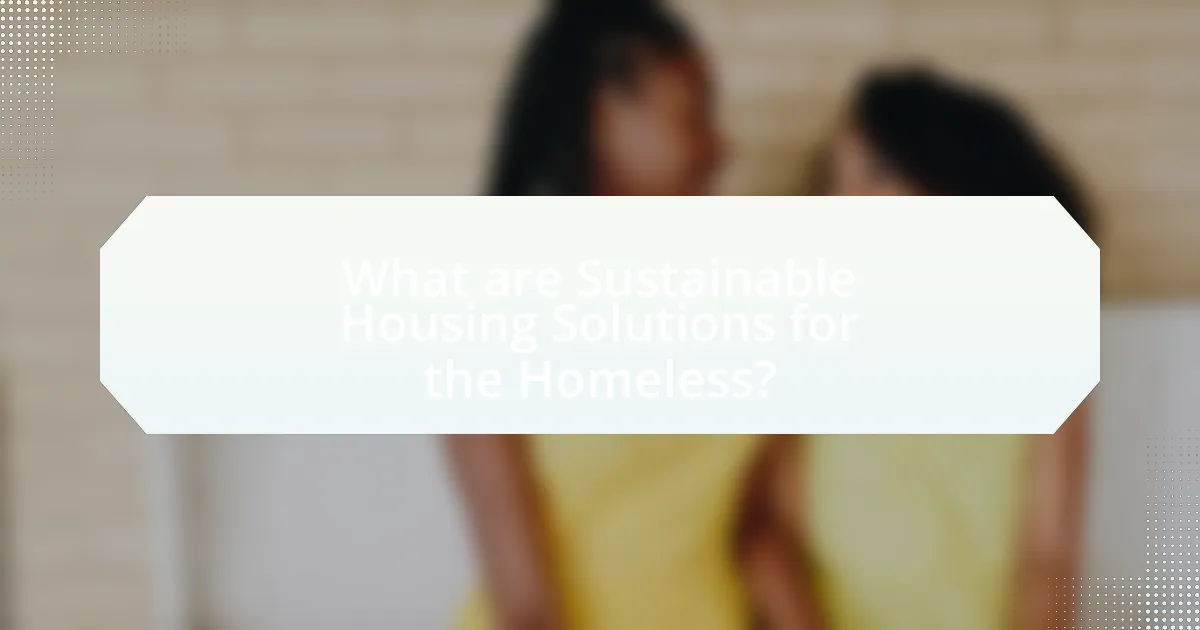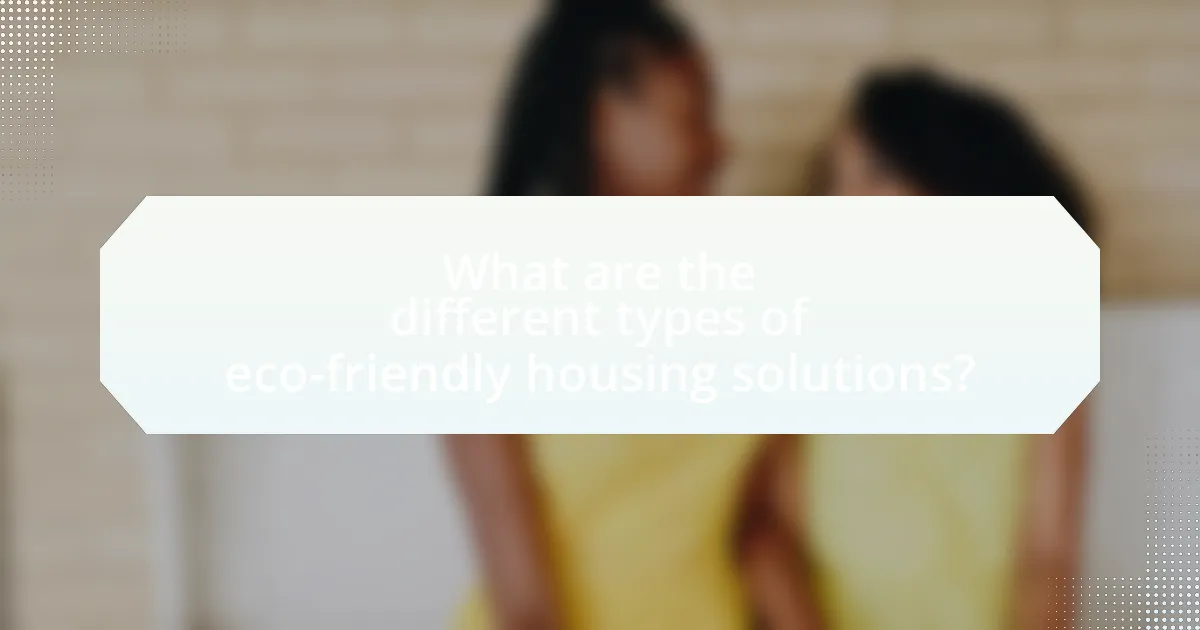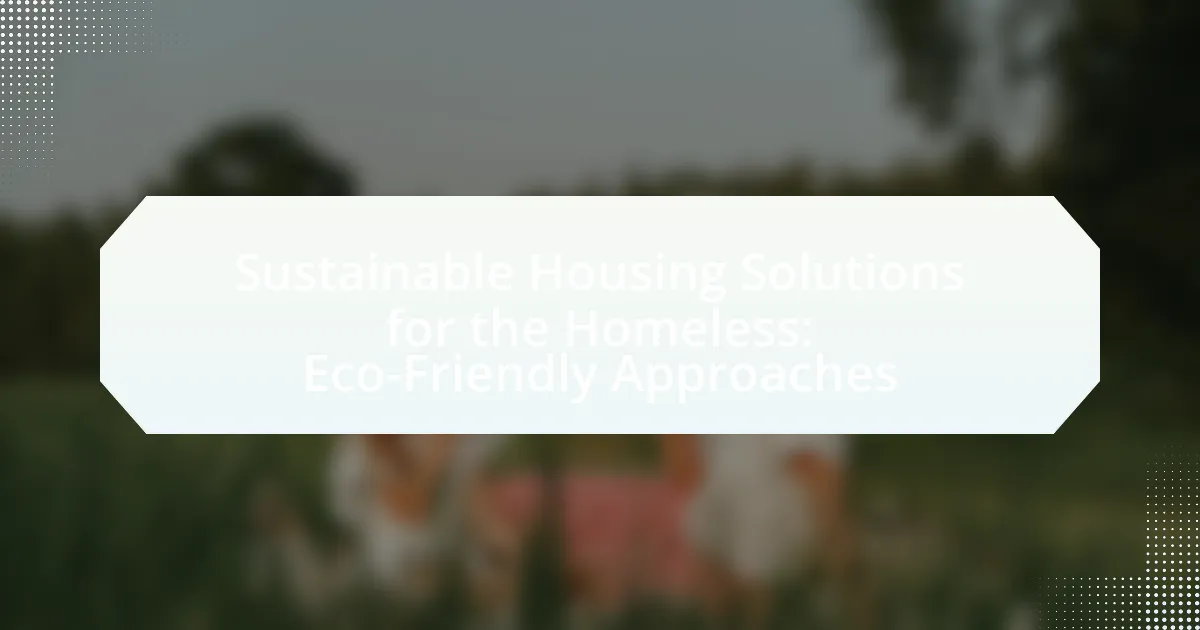Sustainable housing solutions for the homeless encompass various eco-friendly approaches, including tiny homes, modular housing, and shelters built with renewable materials. These solutions aim to provide affordable, permanent housing while minimizing environmental impact and fostering community integration. The article explores how eco-friendly materials, such as bamboo and recycled steel, contribute to sustainability, the social benefits of such housing, and the challenges faced in implementing these initiatives. Additionally, it discusses the role of local governments and policy changes in promoting sustainable housing options, highlighting the importance of addressing the root causes of homelessness through innovative and environmentally conscious designs.

What are Sustainable Housing Solutions for the Homeless?
Sustainable housing solutions for the homeless include tiny homes, modular housing, and eco-friendly shelters that utilize renewable materials and energy-efficient designs. These solutions aim to provide affordable, permanent housing while minimizing environmental impact. For instance, tiny home villages have been successfully implemented in various cities, offering a cost-effective way to house individuals experiencing homelessness. Additionally, modular housing can be rapidly constructed and is often made from sustainable materials, reducing waste and energy consumption during the building process. Studies show that such approaches not only improve living conditions but also foster community integration and support services, leading to better long-term outcomes for residents.
How do eco-friendly approaches contribute to sustainable housing?
Eco-friendly approaches contribute to sustainable housing by utilizing renewable resources, reducing energy consumption, and minimizing waste. These methods often incorporate materials such as bamboo, recycled steel, and reclaimed wood, which lower the environmental impact of construction. For instance, buildings designed with energy-efficient systems can reduce energy use by up to 30%, as reported by the U.S. Department of Energy. Additionally, eco-friendly housing often includes features like solar panels and green roofs, which enhance energy efficiency and promote biodiversity. These practices not only support environmental sustainability but also create healthier living conditions for occupants, demonstrating the multifaceted benefits of eco-friendly approaches in sustainable housing.
What materials are commonly used in eco-friendly housing solutions?
Common materials used in eco-friendly housing solutions include bamboo, reclaimed wood, straw bales, recycled steel, and rammed earth. Bamboo is favored for its rapid growth and strength, making it a sustainable choice. Reclaimed wood reduces waste and adds character to structures. Straw bales provide excellent insulation and are a renewable resource. Recycled steel is durable and minimizes the need for new metal production, while rammed earth utilizes natural soil, offering thermal mass and sustainability. These materials collectively contribute to reducing environmental impact and promoting sustainability in housing.
How do these materials impact the environment and the homeless community?
Eco-friendly materials significantly reduce environmental impact while providing essential shelter for the homeless community. These materials, such as recycled steel, bamboo, and reclaimed wood, minimize waste and lower carbon emissions during production. For instance, using recycled materials can decrease landfill contributions by up to 70%, directly benefiting the environment. Additionally, sustainable housing solutions often incorporate energy-efficient designs, which can lower utility costs for homeless individuals, making housing more accessible. Studies show that sustainable housing can improve the quality of life for homeless populations by providing stable living conditions, which in turn fosters community integration and reduces reliance on emergency services.
Why is sustainable housing important for the homeless population?
Sustainable housing is important for the homeless population because it provides stable, affordable, and environmentally friendly living conditions that can improve their quality of life. By utilizing sustainable materials and energy-efficient designs, these housing solutions reduce utility costs and promote long-term financial stability for residents. Research indicates that sustainable housing can lead to better health outcomes, as it often incorporates features that enhance air quality and access to green spaces, which are crucial for mental and physical well-being. Furthermore, sustainable housing initiatives can foster community engagement and social inclusion, helping to break the cycle of homelessness.
What are the social benefits of providing sustainable housing?
Providing sustainable housing offers significant social benefits, including improved community health, enhanced social cohesion, and increased economic opportunities. Sustainable housing typically incorporates energy-efficient designs and materials, which can lead to lower utility costs for residents, thereby alleviating financial stress and promoting overall well-being. Research indicates that communities with sustainable housing experience lower rates of respiratory illnesses and other health issues due to better indoor air quality and reduced environmental pollutants. Furthermore, sustainable housing fosters a sense of community by encouraging social interactions and collaboration among residents, which can strengthen neighborhood ties. Economic opportunities arise as sustainable housing projects often create jobs in construction, maintenance, and local services, contributing to the local economy and providing employment for residents.
How does sustainable housing address the root causes of homelessness?
Sustainable housing addresses the root causes of homelessness by providing affordable, stable, and environmentally friendly living conditions. This type of housing often incorporates energy-efficient designs and materials, which reduce utility costs and make living more affordable for low-income individuals. For instance, studies show that energy-efficient homes can lower energy bills by 30% or more, directly impacting the financial burden on residents. Additionally, sustainable housing projects often include supportive services such as job training and mental health resources, which tackle underlying issues that contribute to homelessness. By addressing both the economic and social factors associated with homelessness, sustainable housing creates a comprehensive solution that promotes long-term stability and well-being for vulnerable populations.

What are the different types of eco-friendly housing solutions?
Eco-friendly housing solutions include tiny homes, earth-sheltered homes, straw bale houses, and prefabricated modular homes. Tiny homes utilize minimal space and resources, promoting sustainable living with reduced energy consumption. Earth-sheltered homes leverage natural insulation from the surrounding soil, resulting in lower heating and cooling costs. Straw bale houses use renewable materials, providing excellent insulation and reducing the carbon footprint. Prefabricated modular homes are constructed off-site, minimizing waste and allowing for efficient use of materials. Each of these solutions contributes to sustainability by reducing environmental impact and promoting energy efficiency.
How do tiny homes serve as a sustainable option for the homeless?
Tiny homes serve as a sustainable option for the homeless by providing affordable, efficient living spaces that minimize environmental impact. These compact structures typically require fewer resources to build and maintain, leading to lower energy consumption and reduced waste. For instance, tiny homes often utilize sustainable materials and incorporate energy-efficient designs, which can significantly decrease utility costs for residents. Additionally, communities of tiny homes can foster social support networks, enhancing the overall well-being of individuals experiencing homelessness. Studies have shown that such housing solutions can lead to improved health outcomes and increased stability for residents, demonstrating their effectiveness as a sustainable approach to addressing homelessness.
What are the advantages of tiny homes over traditional shelters?
Tiny homes offer several advantages over traditional shelters, including lower costs, reduced environmental impact, and increased mobility. The construction of tiny homes typically requires fewer materials and less energy, leading to a smaller carbon footprint compared to larger, conventional buildings. For instance, the average cost of a tiny home ranges from $10,000 to $30,000, significantly less than the average cost of traditional housing, which can exceed $200,000. Additionally, tiny homes can be placed in various locations, providing flexibility for individuals experiencing homelessness. This adaptability allows for quicker deployment in response to housing crises, making tiny homes a practical solution in sustainable housing initiatives.
How can tiny homes be integrated into existing communities?
Tiny homes can be integrated into existing communities by utilizing vacant lots, underutilized spaces, or as accessory dwelling units (ADUs) on private properties. This approach allows for efficient land use and addresses housing shortages while maintaining community aesthetics. For instance, cities like Portland, Oregon, have successfully implemented tiny home villages, which provide affordable housing options and foster community engagement. Additionally, zoning regulations can be adjusted to accommodate tiny homes, ensuring they meet safety and building codes, which further legitimizes their presence in established neighborhoods.
What role do modular homes play in sustainable housing for the homeless?
Modular homes serve a significant role in sustainable housing for the homeless by providing affordable, quickly constructed, and environmentally friendly living solutions. These homes can be built off-site and assembled on location, reducing construction waste and minimizing the environmental impact associated with traditional building methods. According to a study by the National Institute of Standards and Technology, modular construction can reduce energy consumption during the building process by up to 20%. Additionally, modular homes can be designed with sustainable materials and energy-efficient systems, further enhancing their eco-friendliness. This approach not only addresses immediate housing needs but also promotes long-term sustainability for vulnerable populations.
How are modular homes constructed to minimize environmental impact?
Modular homes are constructed to minimize environmental impact by utilizing efficient building practices and sustainable materials. These homes are prefabricated in controlled factory settings, which reduces waste by optimizing material usage and minimizing on-site construction debris. Additionally, modular homes often incorporate energy-efficient designs, such as high-performance insulation and energy-efficient windows, which lower energy consumption over their lifespan. According to the U.S. Department of Energy, modular construction can reduce energy use by up to 20% compared to traditional building methods. Furthermore, many modular homes are built using recycled or sustainably sourced materials, further decreasing their ecological footprint.
What are the cost implications of modular homes for homeless solutions?
Modular homes significantly reduce costs for homeless solutions by offering a more affordable and efficient construction method compared to traditional housing. The average cost of modular homes ranges from $100 to $200 per square foot, which is often lower than the $200 to $400 per square foot for conventional building methods. Additionally, modular homes can be constructed in a fraction of the time, typically within a few months, leading to reduced labor costs and quicker occupancy.
Research from the National Association of Home Builders indicates that modular construction can save up to 20% on overall project costs due to economies of scale and reduced waste. Furthermore, the speed of construction allows for faster deployment of housing solutions, addressing urgent needs for the homeless population more effectively.

What challenges exist in implementing sustainable housing solutions?
Implementing sustainable housing solutions faces several challenges, including high initial costs, regulatory barriers, and limited access to sustainable materials. High initial costs can deter investment, as sustainable technologies often require significant upfront capital despite long-term savings. Regulatory barriers, such as zoning laws and building codes, may not accommodate innovative sustainable practices, hindering development. Additionally, limited access to sustainable materials can restrict the ability to construct eco-friendly housing, particularly in underserved areas. These challenges collectively impede the widespread adoption of sustainable housing solutions for the homeless.
How do funding and resources affect the development of eco-friendly housing?
Funding and resources significantly influence the development of eco-friendly housing by determining the availability of sustainable materials, technologies, and expertise. Adequate financial support enables developers to invest in renewable energy systems, energy-efficient designs, and environmentally friendly construction practices. For instance, a study by the U.S. Green Building Council found that buildings designed with sustainable practices can reduce energy consumption by up to 30%. Furthermore, access to grants and incentives can lower the initial costs of eco-friendly projects, making them more feasible for developers focused on sustainable housing solutions for the homeless.
What are the common sources of funding for sustainable housing projects?
Common sources of funding for sustainable housing projects include government grants, private investments, non-profit organizations, and crowdfunding platforms. Government grants often support eco-friendly initiatives, with programs like the U.S. Department of Housing and Urban Development providing financial assistance for sustainable development. Private investments from individuals or companies focused on social responsibility can also contribute significantly. Non-profit organizations frequently offer funding or resources for sustainable housing, exemplified by entities like Habitat for Humanity. Additionally, crowdfunding platforms enable community members to invest directly in sustainable housing projects, democratizing funding opportunities. These sources collectively enhance the viability of sustainable housing solutions.
How can communities mobilize resources to support these initiatives?
Communities can mobilize resources to support sustainable housing initiatives for the homeless by forming partnerships with local organizations, businesses, and government agencies. These collaborations can leverage financial contributions, in-kind donations, and volunteer labor to create eco-friendly housing solutions. For instance, a study by the National Alliance to End Homelessness highlights that community-driven efforts, such as fundraising events and awareness campaigns, can significantly increase resource availability. Additionally, utilizing platforms like crowdfunding can attract individual donations, further enhancing the financial support for these initiatives.
What regulatory barriers hinder sustainable housing solutions for the homeless?
Regulatory barriers that hinder sustainable housing solutions for the homeless include zoning laws, building codes, and funding restrictions. Zoning laws often limit the types of housing that can be built in certain areas, making it difficult to implement innovative designs like tiny homes or modular units that are cost-effective and environmentally friendly. Building codes may impose stringent requirements that increase construction costs and timelines, discouraging developers from pursuing sustainable options. Additionally, funding restrictions from government programs can limit the ability to incorporate green technologies or materials, as many grants prioritize traditional housing models over sustainable alternatives. These barriers collectively impede the development of effective and eco-friendly housing solutions for homeless populations.
How can policy changes facilitate the growth of eco-friendly housing options?
Policy changes can facilitate the growth of eco-friendly housing options by providing incentives for sustainable building practices and streamlining regulations that support green construction. For instance, governments can implement tax credits for developers who use renewable materials or energy-efficient technologies, which encourages investment in eco-friendly housing. Additionally, revising zoning laws to allow for the construction of sustainable housing types, such as tiny homes or co-housing developments, can increase the availability of eco-friendly options. Evidence from various cities shows that such policy adjustments lead to a measurable increase in green building projects, contributing to both environmental sustainability and affordable housing solutions.
What role do local governments play in supporting sustainable housing initiatives?
Local governments play a crucial role in supporting sustainable housing initiatives by implementing policies, providing funding, and facilitating partnerships that promote eco-friendly construction and renovation practices. They often establish zoning regulations that encourage sustainable development, offer incentives such as tax credits or grants for green building projects, and create programs that support affordable housing options. For example, the U.S. Department of Housing and Urban Development reported that local governments can leverage federal funds to enhance sustainability in housing, which has been shown to improve energy efficiency and reduce environmental impact.
What practical steps can communities take to promote sustainable housing solutions?
Communities can promote sustainable housing solutions by implementing policies that encourage the use of eco-friendly materials and energy-efficient designs. For instance, local governments can offer incentives such as tax breaks or grants for builders who incorporate sustainable practices, which has been shown to increase the adoption of green building techniques. Additionally, communities can establish partnerships with non-profit organizations to develop affordable housing projects that prioritize sustainability, as evidenced by successful initiatives in cities like Portland, Oregon, where collaborative efforts have led to the construction of energy-efficient homes for low-income families. Furthermore, organizing workshops and educational programs can raise awareness about sustainable living practices among residents, fostering a culture of environmental responsibility that supports long-term housing solutions.

Leave a Reply